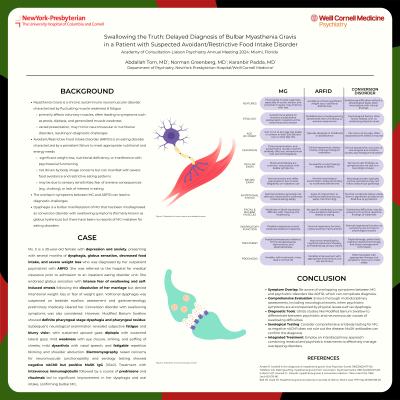Obesity, Nutrition, and Eating Disorders
(115) Swallowing the Truth: Delayed Diagnosis of Bulbar Myasthenia Gravis in a Patient with Suspected Avoidant/Restrictive Food Intake Disorder


Abdallah Tom, MD (he/him/his)
Resident Physician
NewYork Presbyterian Hospital/Weill Cornell Medicine
New York, New York
Abdallah Tom, MD (he/him/his)
Resident Physician
NewYork Presbyterian Hospital/Weill Cornell Medicine
New York, New York
Norman R. Greenberg, MD (he/him/his)
Resident Physician
Weill Cornell Medical Center, Department of Psychiatry
New York City, New York
Norman R. Greenberg, MD (he/him/his)
Resident Physician
Weill Cornell Medical Center, Department of Psychiatry
New York City, New York
Karanbir Padda, MD
Assistant Professor of Clinical Psychiatry
New York-Presbyterian | Weill Cornell Medicine
New York, New York
Karanbir Padda, MD
Assistant Professor of Clinical Psychiatry
New York-Presbyterian | Weill Cornell Medicine
New York, New York
Presenting Author(s)
Co-Author(s)
Background:
Myasthenia Gravis (MG) is an autoimmune neuromuscular disorder that is challenging to diagnose and misattributed to psychosomatic causes. Dysphagia is a bulbar manifestation of MG that has been misdiagnosed as conversion disorder with swallowing symptoms (formerly known as globus hystericus) but there have been no reports of MG mistaken for eating disorders (Tollefson, 1981; Ball, 1971; Antebi, 1963; Fullerton, 1966). Here, we describe a patient experiencing dysphagia initially diagnosed with avoidant/restrictive food intake disorder (ARFID) but later found to have bulbar MG, and review neurological findings to distinguish MG from conversion and eating disorders. Ms. S is a 30-year-old female with depression, anxiety, and histrionic personality traits, presenting with several months of dysphagia, globus sensation, decreased food intake, and severe weight loss who was diagnosed by her outpatient psychiatrist with ARFID. She was referred to the hospital for medical clearance prior to admission to an inpatient eating disorder unit.She endorsed globus sensation with intense fear of swallowing and self-induced emesis following the dissolution of her marriage but denied intentional weight loss or fear of weight gain. Volitional dysphagia was suspected on bedside swallow assessment and gastroenterology preliminary medically cleared her. However, Modified Barium Swallow showed definite pharyngeal stage dysphagia and pharyngeal residue. Subsequent neurological examination revealed subjective fatigue and blurry vision with sustained upward gaze; diplopia with sustained lateral gaze; mild weakness with eye closure, smiling, and puffing of cheeks; mild dysarthria with nasal speech; and fatigable repetitive blinking and shoulder abduction. Electromyography raised concerns for neuromuscular junctionopathy and serology testing showed negative nAChR but positive MuSK IgG (1:640). Treatment with intravenous immunoglobulin followed by a course of prednisone and rituximab led to significant improvement in her dysphagia and oral intake, confirming bulbar MG. MG and neurologic etiologies of weakness have long been on the differential diagnosis for conversion disorder. However, Ms. S’s case highlights the ways in which bulbar MG might be misdiagnosed as an eating disorder, particularly ARFID. Ms. S’s histrionic personality traits, isolation of weakness to bulbar muscles, and preceding psychosocial stressors likely made her more vulnerable to a misdiagnosis of an eating disorder or conversion disorder over organic etiologies. (1) Antebi R. A pitfall in the diagnosis of myasthenia gravis. Acta Psychiatr Scand. 1963;39(3):477-80. (2) Tollefson GD. Distinguishing myasthenia gravis from conversion. Psychosomatics. 1981 Jul;22(7):611-621. (3) Fullerton DT, Munsat TL. Pseudo-myasthenia gravis: a conversion reaction. J Nerv Ment Dis. 1966 Jan;142(1):78-86. (4) Ball JR, Lloyd JH. Myasthenia gravis as hysteria or sounds of silence. Med J Aust. 1971 May 8;1(19):1018-20.
Case:
Discussion:
Conclusion:
Careful attention of the consult-liaison psychiatrist and general internist to neurologic signs and symptoms of bulbar MG, particularly after psychological stressors, is indicated to prevent instances of misdiagnosis as ARFID or conversion disorders.
References:
Presentation Eligibility: Not previously published or presented
Diversity, Equity, and Inclusion: This case report underscores the pivotal role of Consultation-Liaison psychiatry in navigating complex team dynamics, particularly in the context of caring for historically marginalized patients. Our patient’s intersectionality likely played an importance role, as exemplified by the patient's identity as a female of South Asian descent with a history of mental illness. Such intersectionality may have contributed to potential misdiagnoses, highlighting biases related to gender, race, and mental health history. Emphasizing collaborative and multidisciplinary care approaches may mitigate said bias and promote equitable healthcare delivery. Furthermore, the authors of the case report include members historically underrepresented in medicine.

